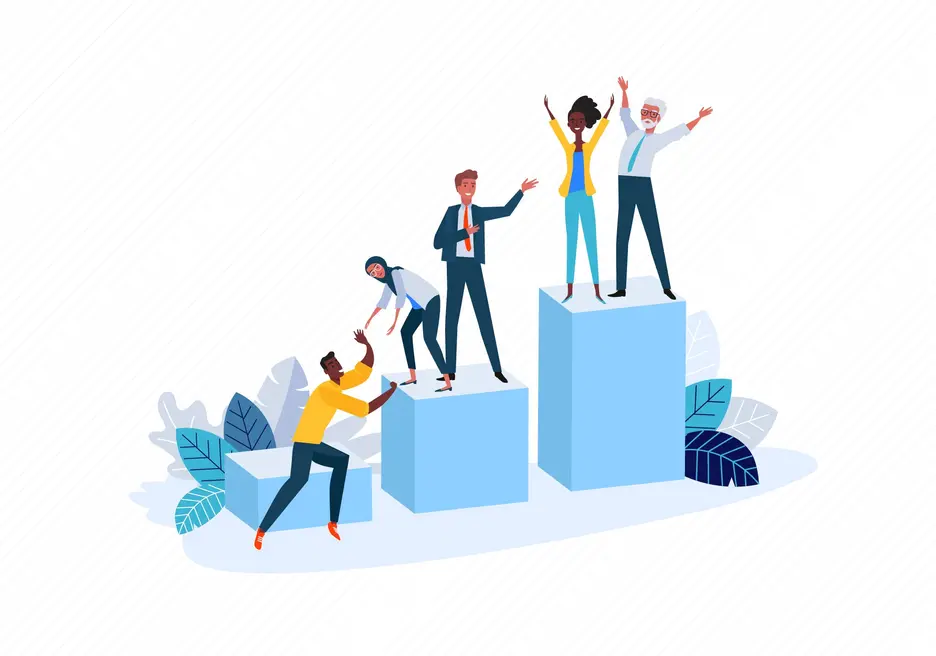Why are diversity and inclusion good for business?

When working with clients, they often pose the same question: “Why should my company care about diversity and inclusion?” Here’s one very good answer: because diversity and inclusion are good for business. In fact, according to a 2018 report by McKinsey, gender diversity in executive teams is strongly correlated with profitability and value creation. As for ethnic and cultural diversity, “companies with the most ethnically diverse executive teams—not only with respect to absolute representation but also of variety or mix of ethnicities—are 33 percent more likely to outperform their peers on profitability,” the report says.
But let’s clear some things up first: What do we mean by diversity and inclusion?
By diversity we refer to all the unique characteristics that make us who we are: personality, lifestyle, work experience, ethnicity, age, culture, disability, gender, sexual orientation. Some of them are for all the world to see, others remain private. Inclusion means respect. Respecting, valuing and considering the different perspectives, styles and needs of people.
Any business needs to attract, develop and retain a workforce that reflects the diversity of the communities in which they operate. This is crucial, because having diversity within their teams will allow them to better engage employees, understand and serve customers, strengthen employer brand and generate creative ideas.
This is no ordinary challenge: as the Global Trends Report 2018: Women's Empowerment Principles shows, “despite a large gap globally in female representation at executive levels, few companies are setting goals and developing the pipeline of women for management positions. In addition, fewer than half the companies had a policy addressing equal pay, and while there is progress in paid leave programs, room for improvement remains”.
You may also like:
- What can businesses learn from crisis management in the digital age?
- Here’s one example of how Big Data helps transportation in our region
- Which countries are leading in PPPs in Latin American and the Caribbean?
The case for diversity and inclusion
Take it from some of the biggest names in tech and media such as Google, Twitter, Hubspot or BuzzFeed. Each year these companies release public updates on Diversity and Inclusion (or as it is referred to, D&I) highlighting progresses and setbacks. BuzzFeed, for example, was forced to layoff around 15 percent of its workforce, or 200 employees in January 2019. How is this reported from the company to the general public? “Our layoffs in January impacted ethnic diversity by less than 1 percent (34.8 percent to 34.4 percent people of color) and gender diversity by about 1 percent (60 percent to 61 percent women)”, wrote Jonah Peretti, BuzzFeed’s founder and CEO, highlighting just how important the very concept of D&I is for the company.
Having a diverse and inclusive workforce and workplace is a strategic business asset. Diversity and inclusion will help businesses to:
- Anticipate and meet customer needs, in an increasingly diverse and volatile marketplace. The more employees reflect the diversity of its customer base and consumers, the more the company will be able to understand and integrate the diverse needs and sensibilities of its customer base to integrate consumers insights into business solutions.
Products and services developed will then be more accurate and therefore deliver a top-class service in line with market needs. We become stronger when we allow our diverse backgrounds and perspectives to come out and better meet the needs of customers.
- Increase our innovation and develop our creativity: Gender and ethnically diverse teams outperform monoculture teams by 35%, according to a popular 2015 McKinsey report on the topic. But also, a 2012 study by Credit Suisse Research found that big companies “with at least one woman on the board have outperformed their peer group with no women on the-board by 26% over the last six years.”
That is to say, the diversity of our workforce will be a source of innovation, creativity and open the door to new perspectives thanks to the diversity of its world vision (cultural, life experiences, background), and the diversity of professional skills (skills, professional paths).
- Attract, retain and develop the best talent: As CIO magazine points out, diversity and inclusion “will not be a ‘nice to have;’ it’ll be a ‘must have’ for companies”. New generations will choose organizations where these topics are a priority, and leave institutions “unwilling to make work, well, work around the needs and demands of their lives.”
By promoting a diverse workforce and driving an inclusive culture, companies will create a positive dynamic for people to thrive and outperform in their roles by giving them the possibility to use their full capabilities. They will also attract the best talent from usual and new talent sources and retain and increase the engagement of employees.
- Reinforce commitments as responsible corporate citizens: Having a diverse workforce and driving an inclusive culture will allow us to reinforce commitments as responsible corporate citizens, as well as to promote a positive, tolerant and open mind-set within teams and with customers.
We’re stronger when we drive a sustainable business caring about the communities and the world where we operate.
The values at hand
At IDB Invest, we recognize the value of diversity and inclusion for businesses. Therefore, we advise companies on creating:
- Inclusive workforce and workplace(focus on their employees).
- Inclusive products or services (create or adapt their existing product or service so it increases access to development, for example, credit lines for women, digital access for rural communities).
- Inclusive value chains (increase the diversity of their providers, for example, the number of women owned/minority owned companies across their value chain).
We also focus on some underrepresented groups, namely women, Afro-descendants, indigenous people, and people with disabilities. It is not often that we see a person in leadership from one of these groups. And it is not by lack of capacity, but often by lack of opportunity for these groups to join the workforce. Imagine how much talent we are missing. How many ideas and creative products do we still need to create?
After having celebrated the World Day for Cultural Diversity, what would Latin America and the Caribbean look like if all its citizens where thriving?
Having an inclusive culture is creating an environment where individuals with different perspectives feel that they belong, that they can fit in without having to change dramatically, that they can represent their diverse experiences within the group. When people experience acceptance, they feel their voice is heard and that their appraisal processes will be conducted in a non-biased way. This way, they’ll rest assured that they’ll be given equal opportunities to show what they are capable of accomplishing.■
LIKE WHAT YOU JUST READ?
Subscribe to our mailing list to stay informed on the latest IDB Invest news, blog posts, upcoming events, and to learn more about specific areas of interest.
Subscribe



